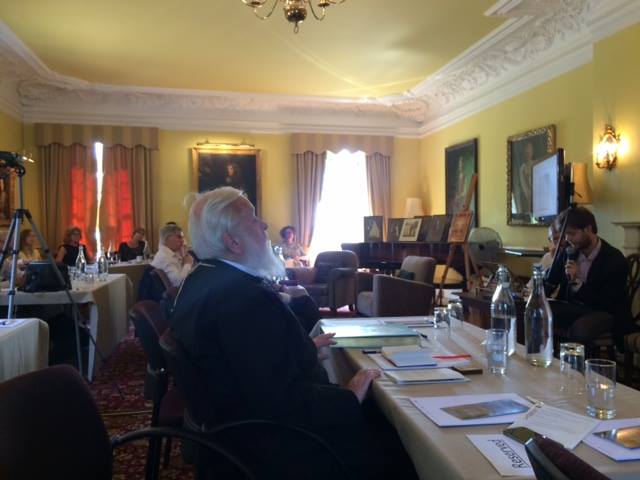Symposium held at Cumberland Lodge, Windsor Park on 20th June 2017
The programme of the Symposium was chosen to coincide with the centenary of the tragic events of 1917-1918: the abdication of Emperor Nicholas II, the two Russian revolutions and the martyrdoms of the Imperial Family and the Grand Duchess Elizabeth. It was entitled “The Last Romanovs: Archival and Museum Discoveries in Great Britain and Russia”.
Five distinguished experts were invited from Russia and the same number from Britain. A total of forty persons were in attendance.
The first Symposium held by the Society took place at the magnificent 17th century house called Cumberland Lodge in Windsor Great Park. The weather on the day matched the setting.
We were particularly honoured by the presence of Archbishop Elisey of Sourozh, head of the Russian Orthodox Church in this country, who blessed and opened the proceedings, Metropolitan Kallistos of the Greek Orthodox Church and Mr Konstantin Shlykov, who represented the Ambassador of the Russian Federation.
The first two speakers of the day dealt with two different Russian Imperial coronations, those of 1896 and 1856.
Professor Inessa Slyunkova, former Head Architect of the Kremlin Museums and author of a number of substantial studies of Royal palaces and residences was unfortunately not able to be present on the day, due to visa problems, but she communicated with us via skype. Her subject was the “Decoration of the Kremlin as sacral space for the last coronation of 1896”. We were able to examine her lavishly illustrated book on the same theme which she had already sent us.
She was followed by Mr Stephen Patterson, Head of Collections Information Management, Royal Collection Trust,who gave an illustrated talk on “Rare photographs of the Romanov’s Russia during the time of the Coronation, 1856”.
The next three speakers were concerned with the Romanovs and the Windsors. Stephen Patterson, replacing a colleague who was unable to attend at the last minute, gave us a fascinating preview of the major exhibition of Russian art and photographs which will be opened at the Queen’s Gallery in 2018. We are very grateful to him for this.
Mr Michael Hunter, the Curator of Osborne House, spoke on “Romanovs at Osborne House: Visits and objects” and showed us some very interesting photographs.
Ms Coryne Hall, researcher and author of a wonderful biography of the Empress Maria Feodorovna, then spoke on the “Rescue of the Dowager Empress Marie Feodorovna from the Crimea” with many revealing quotes from diplomatic letters, including those from King George V.
The afternoon session began with a talk from Nikolai Misko, Researcher at the State Historical Museum, Moscow, on the collection held at that museum which was formerly (until 1947) at the Tsar Nicholas II Museum in Belgrade, founded by prominent members of the Russian emigration in Yugoslavia and elsewhere.
Charlotte Zeepvat, author of many works with royal themes, spoke next on the”Letters of Grand Duchess Maria Alexandrovna of Russia, Duchess of Saxe-Coburg, in the National Archives of Romania in Bucharest”.
Dr Olga Kopylova, Head of Department of the State Archive of the Russian Federation delivered a remarkable talk, based on her exhaustive research in the Moscow Secret Police records, on the Grand Duchess Elizabeth’s daily activities and journeys during the last eight years of her earthly life, when she was under constant police scrutiny for her own protection. It was entitled “2555 Days in the life of Grand Duchess Elizabeth Feodorovna”.
The final session of the Symposium began with a paper, delivered via Skype, from Rev Father Andrei Posternak who is Dean of the History Department at St Tikhon’s Orthodox University in Moscow. It was entitled “The Question of giving the title of Deaconesses to the sisters of the Martha and Mary Convent – discoveries in the St Petersburg Archives”. A lively debate resulted from his talk, in which Father Andrei took a strong line against any possible revival of the ancient order of deaconesses.
Dr Dimitry Grishin, specialist on the life of Grand Duke Sergey Alexandrovich, then spoke on the “Art Collections of Grand Duchess Elizabeth and Grand Duke Sergey: recent discoveries”, describing his work in tracing scattered art works and correcting wrong attributions.
The final paper was given by Rev Archpriest Stephen Platt, of the Institute of Orthodox Christian Studies and a founder member of our Society, entitled “Father Nicholas Gibbes: teacher to the royal children and Orthodox monk. His Romanov collection and the issue of creating a Romanov Museum in Oxford”. This gave us a valuable picture of the present state of this long-running question.
By way of conclusion Metropolitan Kallistos added some vivid personal recollections of Father Nicholas Gibbes and the Orthodox chapel he established in Oxford after the Second World War. We very much appreciated the Metropolitan’s contribution to our event.
In the end the Chairman of the Society Maria Harwood expressed her special gratitude to those who made this Symposium possible by their prayers, generosity and support.
Coverage in the news: http://orthochristian.com/105357.html














